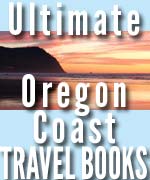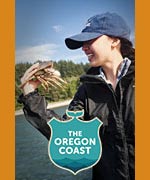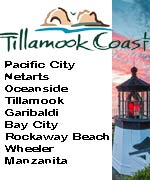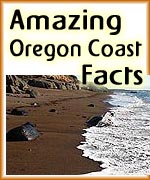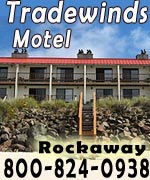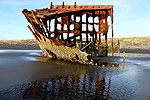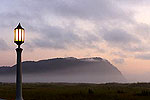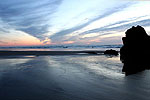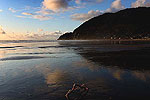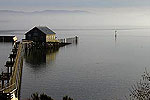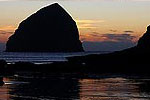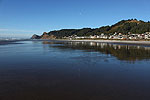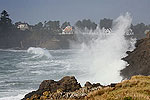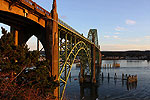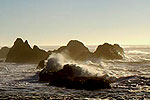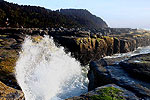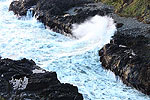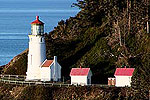 |
Mysterious Structures Reappear on Central Oregon Coast Beach
Published 01/02/2007
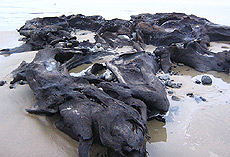 |
| Ancient stumps once buried have reappeared |
(Newport, Oregon) - Some three hundred years ago – so the prevailing theory goes – a massive tsunami hit what would become the Oregon coast, changing the landscape and leveling entire forests, not unlike the blast of Mount St. Helens 25 years ago.
The eerie remnants of this event are now visible again on Newport’s northern beaches, showing a series of strange structures and shapes on the beach that look like some sort of collaboration between Roger Dean (the man who did the Yes album covers) and Dr. Suess.
Head to Moolack Beach or Beverly Beach, on the northern end of town, and you’ll find giant octopus-like structures, the leftovers of root systems dotting the beach. There are currently about nine of the big structures at Moolack, with dozens of smaller tree points sticking out of the sand in various areas.
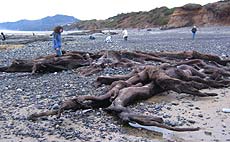 |
| Approximately nine of these structures around this size dot a Newport beach |
These tell a lot of tales of local history and geology – providing much, much more than meets the eye.
The theory is that the infamous earthquake of 1700, which originated in the Pacific, created a frightening tsunami which hit Oregon’s coastline shortly thereafter. It scooped out sand in enormous numbers in some places, killed off local tribes in others, and in low-lying forests it hit with such force that it lopped off the trunks of all the trees, leaving only stumps.
Records show the same quake caused a massive tsunami in Japan.
Lincoln County beach expert Guy DiTorrice said sand has scoured more deeply and earlier in the year than usual, allowing these unusual sights to be seen. “First, the beaches are scouring as nicely as they did in the winter of 1996-97,” DiTorrice said. “Sand movement is related to tides, prevailing currents, time of year and weather. The normal movement of sand is that it comes off the beach to near-shore sandbars during the winter months. It’s more dramatic when the storms are more dramatic.”
There’s more to the story of the stumps, however, said DiTorrice. “The stumps weren't all stumps back when the recorded tsunami of the 1700s occurred,” he said. “We also think there may have been some fault movement here that could have added to these displaced giants of the coastal forests.”
There is some evidence the trees might've been victims of an earthquake so massive it dropped the land abruptly and submerged them.
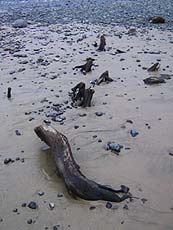 |
| Smaller stumps are visible in some areas |
DiTorrice said when a tsunami of that kind of force hits, it’s likely to rearrange entire beach or soft soil areas, taking such material and shoving it back into cliffs or harder material such as basalt. This could have resulted in any number of directions of movement for the forests or sandy areas.
Also, mankind had a hand in the oddities you see. DiTorrice said early settlers harvested the wood from the stumps, leaving only the mysterious root systems. You can still see the saw marks in many places. “When you look at stumps at their various locations, you need to keep in mind local geology and land movement, as well as potential harvesting of these trees and taller stumps by folks who were here long before us.”
DiTorrice said sand levels are much lower than usual for this early in the year, yet they are not at the extremely low levels they were ten years ago. “I expect it to happen, though,” he said. “We’ll get there.”
This means viewing of the strange stumps will only improve. But the sand has a ways to go still.
“I was on Moolack this past weekend for the first time since early October - because the sand is definitely moving and exposing gravel bars and troughs,” DiTorrice said. “However, the sand movement is spotty, scattered and still minimal. For example, rocks are barely exposed where I know the material is a couple feet thick. And, I've seen as much new landslides - which create even more sand - in areas that haven't slid in some time. Remember those folks in Lincoln City a month or so ago who lost 20-plus feet of their linear beach ‘protection’ and almost lost their houses?”
Currently, much of Moolack is a near moonscape of wild shapes and rocky slabs left exposed by the low sand levels.
DiTorrice, who is also a beach fossil expert and fossil tour guide known as Oregon Fossil Guy, added all this sand movement will make conditions prime for finding fossils anywhere on the Oregon coast. “Rocks and fossils can be found on any sandy beach in Oregon, especially where the Pacific gets a chance to crash a wave or two on non-basalt landforms,” DiTorrice said. “Those beaches with large gravel bars, low-tide sandstone or siltstone troughs will be providing good rock- and fossil-collecting the months ahead.”
There are stump areas visible at Beverly Beach. In Nye Beach, there is a stump sticking out of the cliff just beneath the Sylvia Beach Hotel, which is from the same event. Periodically, Newport authorities get a call from a concerned visitor or citizen saying they think the stump may pose a danger of falling.
There are other, older such stumps in Neskown, just south of Pacific City. These two thousand-year-old specimens are also usually quite visible at low sand level years such as this winter. This one is nicknamed the “ghost forest,” and is the result of a massive earthquake which dropped the forest perhaps as much as 25 feet into the surf, thus preserving the stumps. The tops of these trees were also lopped off by a massive tsunami, although scientists do not know if that tsunami came from the actual earthquake or it was a subsequent tsunami, such as the one in 1700.
Moolack Beach is just north of Newport. There are two entryways to the beach – both rather slippery, so take extreme caution. Use the northern access, not the southern one. The northern access is much less slippery. More on Newport can be found at Newport, Oregon Virtual Tour.
More About Newport Lodging, hotels.....
More About Newport Restaurants, Dining.....
 |
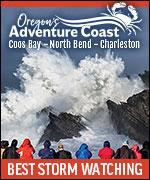 |
 |
Back to Oregon Coast
Contact Advertise on BeachConnection.net
Secrets of the Season |
Unusual Travel Articles TravelParanormal.com allows you to submit your own creepy tale or debunk one - or see up-to-the-minute news headlines about travel and the paranormal. News Headlines from All Over Oregon Need to scan Oregon headlines? Constantly updated news from all over Oregon: a comprehensive, up-to-the-minute display of news headlines from a variety of media |




